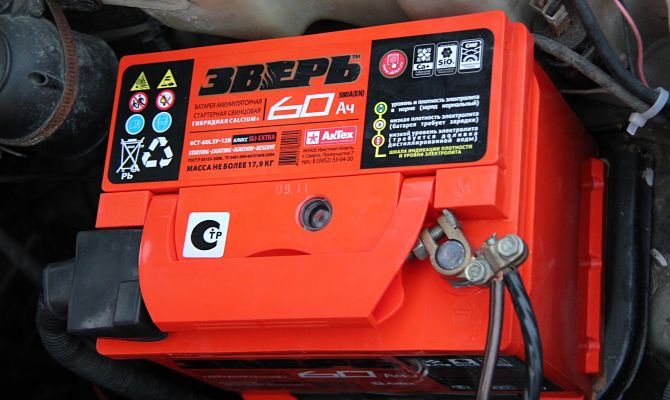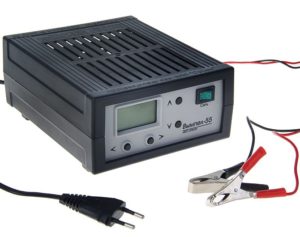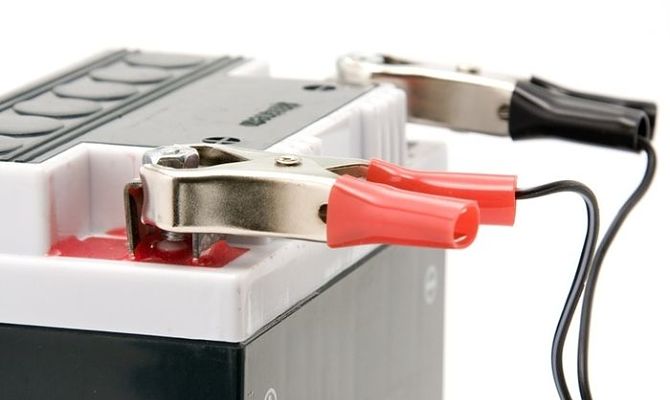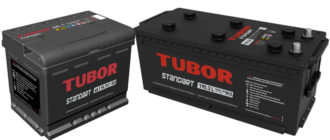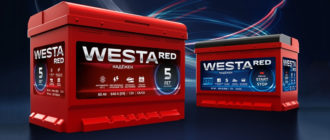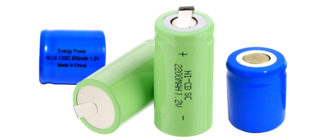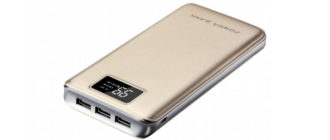All car owners sooner or later face the need to choose a battery. Depending on the operating conditions, batteries require replacement approximately 1 time in 3-5 years, despite the fact that manufacturers sometimes promise a service life of up to 7-10 years. Scientific and technological progress also captures this area of production, the production of hybrid batteries is a vivid confirmation of this.
Content
- What is a hybrid battery?
- Used technology in hybrid batteries
- What is the difference from low antimony and calcium batteries
- Where are hybrid batteries used?
- Advantages and disadvantages
- Hybrid Battery Maintenance
- Life time
- How to choose a memory
- How to charge a hybrid battery
- Video: How to properly charge a hybrid battery
- How to restore a hybrid battery
What is a hybrid battery?
The semantics of the word "hybrid" already suggests that we are talking about a combination of different directions. In this case, this is the crossing of technological processes for the production of batteries, based on the use of electrolyte properties of two chemical elements - calcium and antimony.
About half of the plates in the hybrid battery are lead-antimony, the other half are lead-calcium. Marking on Calcium Plus or Ca + car batteries means that the product is manufactured using hybrid technology. Sometimes on the case it is written: hybrid Calcium +.
Used technology in hybrid batteries
Hybrid technology car batteries have combined the best designs of expensive calcium batteries with their unpretentious service conditions for antimony models. Hybrid-battery lead-antimony lattices carry a positive charge, calcium lead-negative - negative.
An alloy with calcium content is obtained at low temperature. This ensures grating rigidity and corrosion resistance. The use of calcium in the technology of manufacturing a hybrid battery leads to a significant reduction in the volume of liquid vapor and protects against self-discharge. Due to its properties, the lead-antimony lattice gives resistance to deep discharges.
What is the difference from low antimony and calcium batteries
Lead is soft; it cannot be used in its pure form. The addition of antimony gives the plates the necessary strength, but causes the electrolyte to “boil”, which means its evaporation. Therefore, it is necessary to constantly add distilled water to the banks. The excess in lead electrodes of 5% of the antimony content threshold indicates that this is an outdated model. In modern batteries, there is already significantly less Sb.
Low antimony models are the next generation, which belongs to the category of low-maintenance. In hybrid batteries, the evaporation volume is much less than that of low antimony batteries, and this is their main difference.
Adding calcium to lead grids instead of antimony is the next step on the path to battery evolution. Sometimes they add a small amount of silver. In calcium batteries, the electrolyte evaporates much more slowly, and there are sealed, completely maintenance-free models. They have increased efficiency and capacity.
Hybrid batteries have adopted low self-discharge from calcium and the ability to use thinner lead gratings. They have a significant difference: they are not subject to deep discharges - a property obtained from antimony batteries.
| Type of | Self discharge | Deep discharge | Serviceability | Cost |
|---|---|---|---|---|
| Antimony | Tall | Tolerate well | Often | Cheap |
| Hybrid | Middle | Normally tolerated | Low maintenance | average cost |
| Calcium | Low | Poorly tolerated | Low maintenance or maintenance free | Expensive |
Where are hybrid batteries used?
Thanks to a combination of advanced technological solutions from two types of batteries, a profitable combination was obtained. The characteristics of the hybrid device allow you to put them on used cars, which may have unstable voltage on-board network.
The practicality of such a power source and long service life is optimal for inexpensive domestic cars and foreign cars. In this case, the main condition of choice is low-maintenance due to calcium additives and the durability of antimony plates.
Advantages and disadvantages
Hybrid batteries have more pros than cons:
Significantly reduced fluid flow. Significantly decreased the level of electrolyte boiling.
- The risk of self-discharge is minimized.
- High inrush currents. The increase in efficiency became possible due to the use of lead-calcium negatively charged electrodes. Special processing of the plates prevents their oxidation. Hence the good current-output parameters.
- Since Calcium Plus suggests the use of a lead-antimony positive electrode, resistance to deep discharges has significantly increased.
- Hybrid battery cold-scroll current options make it easy to start the engine in winter.
There are few disadvantages, but they need to be taken into account:
- Still, you will have to add distilled water from time to time, especially in the heat.
- Hybrid batteries have a higher cost than low antimony ones.
- A lot of fake merchandise. Therefore, you need to buy them from reliable suppliers.
Hybrid Battery Maintenance
Hybrid devices are low-maintenance, but still 1 time in 3 months will have to remove the cover and check the electrolyte level. On average, at a time it will be necessary to add water with a volume of 0.5 liters.
If you regularly check the volume of the electrolyte and its density, then the battery will not have a problem. Most models have marks indicating what the electrolyte level should be. Some manufacturers equip their products with an indicator.
Maintenance includes cleaning white plaque - lead sulfate. This is a normal phenomenon that results from a chemical reaction associated with lead.
With improper acidity of the composition, the destruction of the plates can be accelerated, and no repair will help. If desulfation is carried out periodically, this process can be stopped.
Life time
When choosing a power source for a car, you should pay attention to the release date. The fresher the product, the better. Ideally - 2-3 months from the date of release.
The advantages of a hybrid type of power supply include a long service life. Most manufacturers guarantee stable performance of their tasks for 5-7 years.
To extend the period of operation, it is necessary to check the electrolyte level, to clean the grates from sulfates in time.
Important! The durability of the vehicle’s power source is affected by temperature conditions, electrical circuit health, and even driving style.
How to choose a memory
In order to avoid problems with recharging the power source, you should be responsible for choosing a charger:
- The charger should give the optimal voltage for recharging - 13.8-14.2 V.
- The requirements for the maximum output current, on which the charging time depends, are determined by the battery capacity indicated by the manufacturers. Powerful charger, charge a more powerful battery.
- The memory must have a phased adjustment of the output voltage.
- The transformer must be equipped with a current limiter.
- It is best to purchase a model with an automatic control unit to avoid tuning errors.
- Ideally, if the charger can block the charging process if the terminals are connected incorrectly and have protection against voltage surges in the network.
Charging options charge the battery for a long time, but sparingly. Start-charging models operate in accelerated mode and have a quick recovery function.They carry out desulfation, restore the factory capacity of the battery.
How to charge a hybrid battery
It is necessary to charge the battery if the density of the electrolyte has dropped to 1.22 g / cm. cube or if the voltage drops below 12 V.
The scheme is as follows:
- Wipe the case from dirt and moisture;
- Open the lids so that the gases arising from boiling come out;
- If necessary, add distilled water;
- Connect the "pluses", then the "minuses" of the battery terminals and the charger;
- Turn on the power to the transformer.
Every 1.5-2 hours, you need to check the following parameters:
- the value of the charging current (not more than a tenth of the battery capacity),
- voltage (no more than 14.2 V);
- density and temperature of the electrolyte (+30 C, not more than +45 C).
A charged hybrid battery produces a voltage of 14.2 V, the current drops to a value of 0.5 amperes. Visually, this is determined by the appearance of bubbles.
Upon completion of recharging, you need to check the electrolyte level in each section. Add, if necessary, a distiller, tightly close all the necks.
It is better not to give high currents, as this adversely affects the state of the battery, as well as lead to more active evaporation of the electrolyte. And it is poisonous and explosive.
Video: How to properly charge a hybrid battery
How to restore a hybrid battery
Hybrid battery recovery is possible with the following malfunctions:
- Shorting the plates. Do washing with distilled water until the moment when the coal chips stop going.
- Sulfated plates. It can be eliminated using a cycle of short and weak charge-discharges, or chemical reagents poured into banks. Effectively clean plates mechanically by hand. But this requires special knowledge and skills to eliminate battery damage .;
When using additives to dissolve sulfites, this solution should be kept in the battery for 48 hours.
Recovering a frozen battery does not make sense. This is expressed in the swollen sides, instant boiling of the electrolyte, the closure of the electrodes.
A battery that is "killed" by a huge current charge cannot be restored. Therefore, do not use charging transformers that are not equipped with an adjustment function.
Still have questions about Hybrid batteries or have something to add? Then write to us about it in the comments, this will make the material more useful, complete and accurate.






